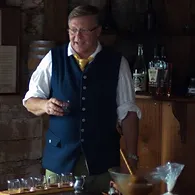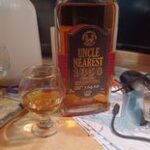Friendship and whiskey get better over time. I believe men who make, and drink whiskey together will remain friends. The original process is primal. Moreover, the simple 18th century techniques, practiced at the Eichelberger Distillery keep it elemental, as opposed to the technological processes of modern distillation. Menial actions such as grinding grain, chopping wood, heating water over open fire, stirring mash and pitching yeast to get fermentation going is basic hard work and satisfying when accomplished. These shared experiences are the kinds of tasks that bring men together. It is a joyful experience to see mash happily bubbling as yeast mysteriously transforms sweet, grainy soup into a slightly alcoholic brew readying it to be transformed into a clear “spirit”.

If yeast transformation appears mysterious, the next step is magical. In fact, destillare’, Latin for “to drip down” was associated with wizards, sorcerers, and magicians creating potions perfumes or elixirs. The tool they used for this task was the alembic still, attributed to Marie the Jewess, an Egyptian alchemist (think early chemical engineer) who not only invented this type of reflux condenser but also developed the double boiler or bain-marie.
Over centuries, improvements were made until today’s copper and stainless-steel beauties arrived. They are efficient, predictable, and capable of producing large volumes of spirits. Our stills are not very efficient and do not come from Vendome or Hillbilly Stills; we built them. We annealed the copper, bent, pounded, and shaped them on an English Wheel, then (welded) and riveted sections together. We shared the challenges as she came into existence. It was a real bonding experience.

With a still built, we sat around “her” like nervous new fathers as she was about to bear the “fruits” of our labor. We stoked the fire and watched the temperature rise past 173. What? No dripping? 180 …184 … was something wrong? Finally, the first droplet appeared, followed by many more drips that turned into a stream. The taste? It was an ugly baby! But no parent is going to admit their newborn child is unappealing. We embraced the unseemly spirit and made improvements. It got better and more consistent. We were proud parents. Along the way we felt the frustration and elation that comes with figuring something out. We persevered and celebrated together.
Friendships, like whiskey, need time to develop. The bonds between friends and the bonds between ethanol and congeners change, grow and hopefully flourish over time. Attempting to make an 18th century whiskey in the 21st century is already difficult. There is room for interpretation and lots of areas for disagreement on details of early whiskey making. That’s just the whiskey making part. The Eichelberger Distillery is part of a non-profit, volunteer historical society. Social interaction in volunteer organizations creates opportunities for exchange, cooperation and accommodation; the bonding part. But competition and conflict also happen. Those parts must be understood, mellowed, and aged to control bad “tastes” that can develop.

Conflict eventually arose. I assumed that the bonding that occurred from the persistence we displayed would prevent further fracture. The spirit would improve. I invited the differing parties to share a fireside glass of whiskey that had now aged. We agreed; the baby had gotten better. But that was the extent of the agreement. Feelings were still hurt, offenses remained, and walls were still intact.
Reluctantly, I put the whiskey back in the barrel. It might just need a little more time!





